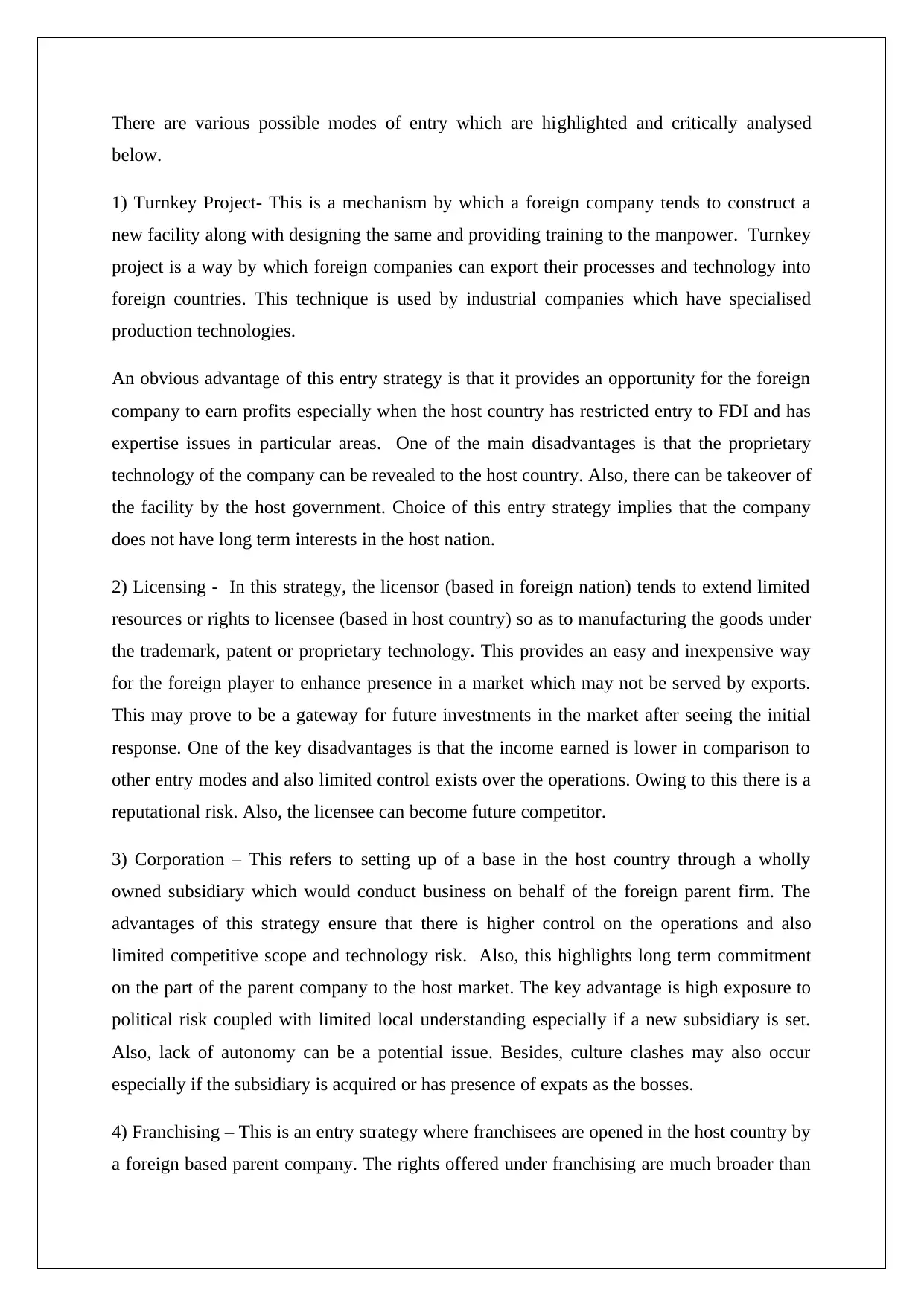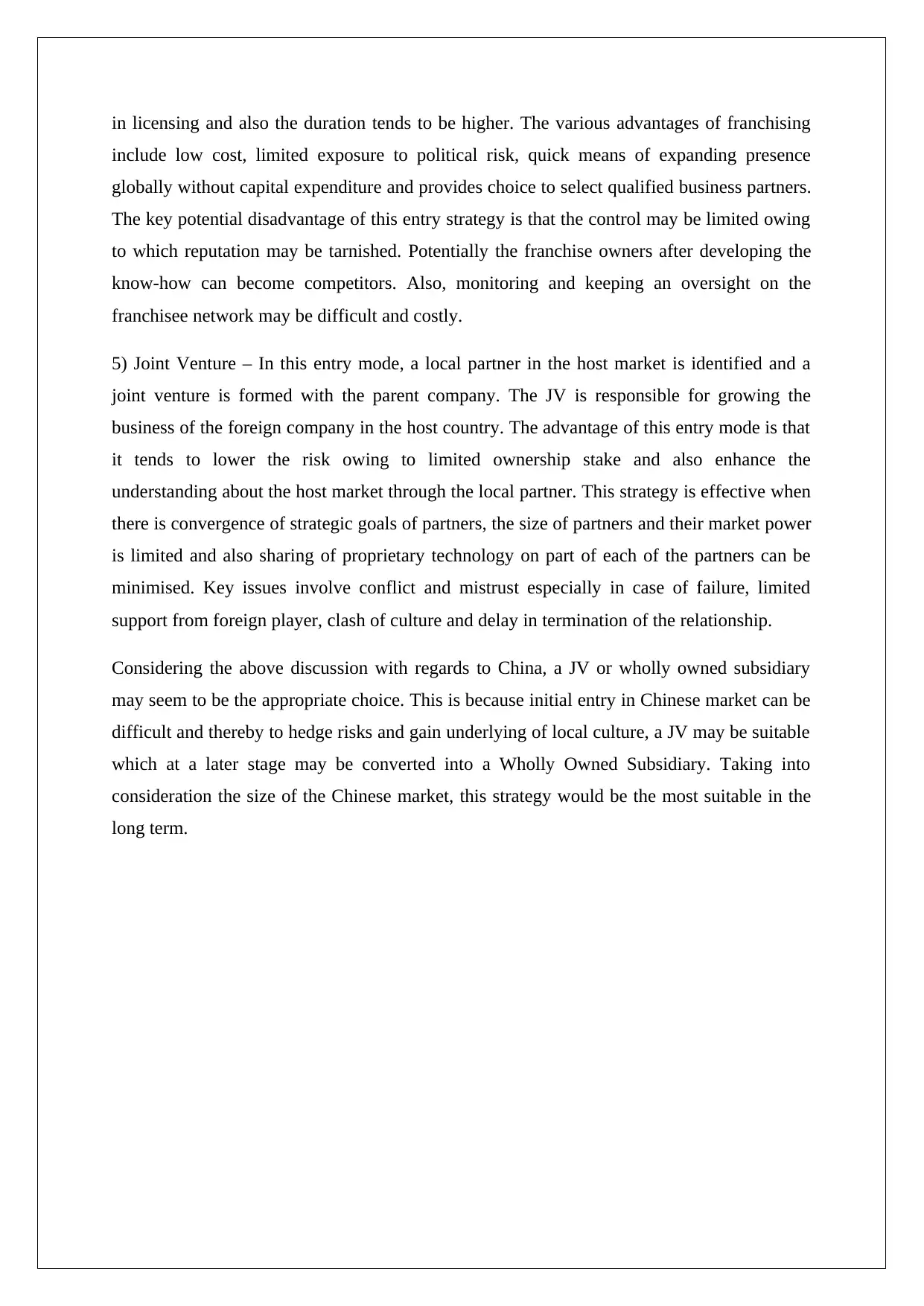International Business: Modes of Entry Report and Analysis
VerifiedAdded on 2023/06/03
|3
|813
|427
Report
AI Summary
This report provides a comprehensive analysis of various modes of entry for international businesses. It explores five key strategies: turnkey projects, licensing, wholly owned subsidiaries, franchising, and joint ventures. Each mode is critically examined, highlighting its advantages and disadvantages, such as the potential for profit, technology transfer, control, and risk exposure. The report considers the specific context of the Chinese market, suggesting that a joint venture or a wholly owned subsidiary might be the most appropriate entry strategy. A joint venture is recommended for initial risk mitigation and local market understanding, with the potential for conversion into a wholly owned subsidiary for long-term growth, given the size and complexity of the Chinese market.

MODES OF ENTRY
STUDENT ID:
[Pick the date]
STUDENT ID:
[Pick the date]
Paraphrase This Document
Need a fresh take? Get an instant paraphrase of this document with our AI Paraphraser

There are various possible modes of entry which are highlighted and critically analysed
below.
1) Turnkey Project- This is a mechanism by which a foreign company tends to construct a
new facility along with designing the same and providing training to the manpower. Turnkey
project is a way by which foreign companies can export their processes and technology into
foreign countries. This technique is used by industrial companies which have specialised
production technologies.
An obvious advantage of this entry strategy is that it provides an opportunity for the foreign
company to earn profits especially when the host country has restricted entry to FDI and has
expertise issues in particular areas. One of the main disadvantages is that the proprietary
technology of the company can be revealed to the host country. Also, there can be takeover of
the facility by the host government. Choice of this entry strategy implies that the company
does not have long term interests in the host nation.
2) Licensing - In this strategy, the licensor (based in foreign nation) tends to extend limited
resources or rights to licensee (based in host country) so as to manufacturing the goods under
the trademark, patent or proprietary technology. This provides an easy and inexpensive way
for the foreign player to enhance presence in a market which may not be served by exports.
This may prove to be a gateway for future investments in the market after seeing the initial
response. One of the key disadvantages is that the income earned is lower in comparison to
other entry modes and also limited control exists over the operations. Owing to this there is a
reputational risk. Also, the licensee can become future competitor.
3) Corporation – This refers to setting up of a base in the host country through a wholly
owned subsidiary which would conduct business on behalf of the foreign parent firm. The
advantages of this strategy ensure that there is higher control on the operations and also
limited competitive scope and technology risk. Also, this highlights long term commitment
on the part of the parent company to the host market. The key advantage is high exposure to
political risk coupled with limited local understanding especially if a new subsidiary is set.
Also, lack of autonomy can be a potential issue. Besides, culture clashes may also occur
especially if the subsidiary is acquired or has presence of expats as the bosses.
4) Franchising – This is an entry strategy where franchisees are opened in the host country by
a foreign based parent company. The rights offered under franchising are much broader than
below.
1) Turnkey Project- This is a mechanism by which a foreign company tends to construct a
new facility along with designing the same and providing training to the manpower. Turnkey
project is a way by which foreign companies can export their processes and technology into
foreign countries. This technique is used by industrial companies which have specialised
production technologies.
An obvious advantage of this entry strategy is that it provides an opportunity for the foreign
company to earn profits especially when the host country has restricted entry to FDI and has
expertise issues in particular areas. One of the main disadvantages is that the proprietary
technology of the company can be revealed to the host country. Also, there can be takeover of
the facility by the host government. Choice of this entry strategy implies that the company
does not have long term interests in the host nation.
2) Licensing - In this strategy, the licensor (based in foreign nation) tends to extend limited
resources or rights to licensee (based in host country) so as to manufacturing the goods under
the trademark, patent or proprietary technology. This provides an easy and inexpensive way
for the foreign player to enhance presence in a market which may not be served by exports.
This may prove to be a gateway for future investments in the market after seeing the initial
response. One of the key disadvantages is that the income earned is lower in comparison to
other entry modes and also limited control exists over the operations. Owing to this there is a
reputational risk. Also, the licensee can become future competitor.
3) Corporation – This refers to setting up of a base in the host country through a wholly
owned subsidiary which would conduct business on behalf of the foreign parent firm. The
advantages of this strategy ensure that there is higher control on the operations and also
limited competitive scope and technology risk. Also, this highlights long term commitment
on the part of the parent company to the host market. The key advantage is high exposure to
political risk coupled with limited local understanding especially if a new subsidiary is set.
Also, lack of autonomy can be a potential issue. Besides, culture clashes may also occur
especially if the subsidiary is acquired or has presence of expats as the bosses.
4) Franchising – This is an entry strategy where franchisees are opened in the host country by
a foreign based parent company. The rights offered under franchising are much broader than

in licensing and also the duration tends to be higher. The various advantages of franchising
include low cost, limited exposure to political risk, quick means of expanding presence
globally without capital expenditure and provides choice to select qualified business partners.
The key potential disadvantage of this entry strategy is that the control may be limited owing
to which reputation may be tarnished. Potentially the franchise owners after developing the
know-how can become competitors. Also, monitoring and keeping an oversight on the
franchisee network may be difficult and costly.
5) Joint Venture – In this entry mode, a local partner in the host market is identified and a
joint venture is formed with the parent company. The JV is responsible for growing the
business of the foreign company in the host country. The advantage of this entry mode is that
it tends to lower the risk owing to limited ownership stake and also enhance the
understanding about the host market through the local partner. This strategy is effective when
there is convergence of strategic goals of partners, the size of partners and their market power
is limited and also sharing of proprietary technology on part of each of the partners can be
minimised. Key issues involve conflict and mistrust especially in case of failure, limited
support from foreign player, clash of culture and delay in termination of the relationship.
Considering the above discussion with regards to China, a JV or wholly owned subsidiary
may seem to be the appropriate choice. This is because initial entry in Chinese market can be
difficult and thereby to hedge risks and gain underlying of local culture, a JV may be suitable
which at a later stage may be converted into a Wholly Owned Subsidiary. Taking into
consideration the size of the Chinese market, this strategy would be the most suitable in the
long term.
include low cost, limited exposure to political risk, quick means of expanding presence
globally without capital expenditure and provides choice to select qualified business partners.
The key potential disadvantage of this entry strategy is that the control may be limited owing
to which reputation may be tarnished. Potentially the franchise owners after developing the
know-how can become competitors. Also, monitoring and keeping an oversight on the
franchisee network may be difficult and costly.
5) Joint Venture – In this entry mode, a local partner in the host market is identified and a
joint venture is formed with the parent company. The JV is responsible for growing the
business of the foreign company in the host country. The advantage of this entry mode is that
it tends to lower the risk owing to limited ownership stake and also enhance the
understanding about the host market through the local partner. This strategy is effective when
there is convergence of strategic goals of partners, the size of partners and their market power
is limited and also sharing of proprietary technology on part of each of the partners can be
minimised. Key issues involve conflict and mistrust especially in case of failure, limited
support from foreign player, clash of culture and delay in termination of the relationship.
Considering the above discussion with regards to China, a JV or wholly owned subsidiary
may seem to be the appropriate choice. This is because initial entry in Chinese market can be
difficult and thereby to hedge risks and gain underlying of local culture, a JV may be suitable
which at a later stage may be converted into a Wholly Owned Subsidiary. Taking into
consideration the size of the Chinese market, this strategy would be the most suitable in the
long term.
⊘ This is a preview!⊘
Do you want full access?
Subscribe today to unlock all pages.

Trusted by 1+ million students worldwide
1 out of 3
Related Documents
Your All-in-One AI-Powered Toolkit for Academic Success.
+13062052269
info@desklib.com
Available 24*7 on WhatsApp / Email
![[object Object]](/_next/static/media/star-bottom.7253800d.svg)
Unlock your academic potential
Copyright © 2020–2025 A2Z Services. All Rights Reserved. Developed and managed by ZUCOL.





